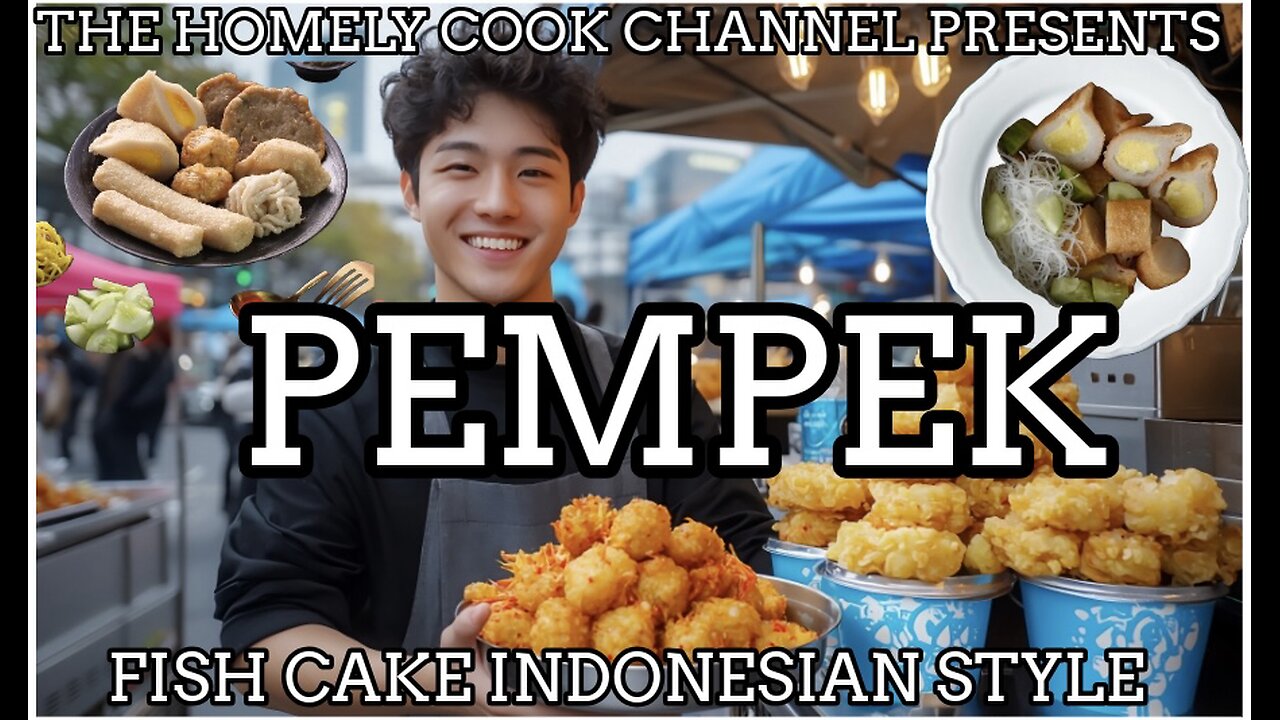Premium Only Content

PEMPEK: FISH CAKE INDONESIAN STYLE
Pempek is a traditional Indonesian fish cake that originates from Palembang, the capital of South Sumatra. It is made from a mixture of ground fish (usually mackerel or tenggiri), tapioca flour, and water, giving it a chewy texture. Pempek is typically served with cuko, a dark, tangy, and spicy sauce made from palm sugar, vinegar, garlic, and chili.
History of Pempek
The origins of pempek date back to the 16th century during the era of the Palembang Sultanate. According to local legend, a man named Apek, a Chinese immigrant living in Palembang, was dissatisfied with the usual way of eating fish. He experimented by grinding fish meat, mixing it with tapioca flour, and frying it, creating what is now known as pempek. Some believe that the dish was influenced by Chinese fish cake recipes but adapted to local ingredients and tastes.
Development & Popularity
• Dutch Colonial Era: Pempek became more popular as Palembang was an important trade hub.
• Nationwide Spread: As Indonesians migrated across the country, they brought pempek with them, making it a beloved dish beyond Sumatra.
• Varieties: Over time, different shapes and styles of pempek were created, such as pempek kapal selam (stuffed with egg), pempek lenjer (cylindrical), and pempek adaan (fried round balls).
Today, pempek is one of Indonesia’s most famous street foods and is enjoyed by people from all backgrounds.
Popularity of Pempek
Pempek is one of Indonesia’s most beloved street foods, especially in Palembang, South Sumatra, where it originated. Over time, its popularity has spread across Indonesia and even internationally due to its unique taste and cultural significance.
Why Is Pempek So Popular?
1. Rich Culinary Heritage
• Pempek has been a staple in South Sumatran cuisine since the 16th century, making it a cultural icon.
• It is deeply tied to Palembang’s identity and is often the first food associated with the city.
2. Unique Flavor & Texture
• The chewy texture from fish and tapioca flour makes it distinct from other Indonesian snacks.
• Cuko sauce (a spicy, tangy, and sweet vinegar-based sauce) enhances the taste, making it addictive.
3. Easy to Find Across Indonesia
• Although it originated in Palembang, pempek is now available nationwide, especially in major cities like Jakarta, Bandung, and Surabaya.
• Many Palembang natives who migrated to other regions have opened pempek restaurants and stalls, increasing its reach.
4. Adaptability & Variations
• Different types of pempek have been created to cater to different tastes, such as:
• Pempek Kapal Selam (stuffed with egg)
• Pempek Lenjer (cylindrical shape)
• Pempek Adaan (fried round balls)
• Modern versions sometimes bake or air-fry pempek to cater to health-conscious consumers.
5. International Recognition
• Indonesian communities abroad have introduced pempek in countries like Malaysia, Singapore, Australia, and the Netherlands.
• Some Indonesian restaurants in Europe and the U.S. serve pempek, increasing its global exposure.
6. Social Media & Online Sales
• The rise of food delivery apps has made it easier for people outside Palembang to order pempek.
• Social media platforms like Instagram, TikTok, and YouTube have popularized pempek, attracting younger generations to try it.
Modern Popularity Trends
• Festivals & Events: Pempek is a highlight at Indonesian food festivals worldwide.
• Packaged Pempek: Many brands sell frozen pempek for easy cooking at home.
• Creative Fusions: Chefs experiment with pempek-based dishes, like pempek pizza or PEMPEK
#Pempek
#PempekPalembang
#PempekEnak
#PempekAsli
#PempekKapalSelam
#KulinerPalembang
#MakananKhasPalembang
#PempekLenggang
#CukoPempek
#IndonesianFood
#FoodLover
#StreetFood
#Foodie
#Foodstagram
#Yummy
#Delicious
#FoodPorn
#FoodPhotography
#FoodGasm
#FoodVlogger
#JualPempek
#PempekFrozen
#PempekOnline
#KulinerIndonesia
#IndonesianCuisine
#HomeMadeFood
-
 LIVE
LIVE
VINCE
1 hour agoThe Numbers Don't Lie: Trump's War on Crime Is Working | Episode 148 - 10/16/25
27,654 watching -
 LIVE
LIVE
Dear America
2 hours agoDems Are IN SHAMBLES!!! Is NYC Electing a JIHADIST?! + FBI Cracks down on Crime!!
2,377 watching -
 LIVE
LIVE
Matt Kohrs
12 hours agoLive Trading Futures & Options || Stock Market Open
852 watching -
 LIVE
LIVE
Wendy Bell Radio
5 hours agoWhat A Long, Strange Trip It's Been
7,652 watching -
 LIVE
LIVE
LFA TV
12 hours agoLIVE & BREAKING NEWS! | THURSDAY 10/16/25
4,122 watching -
 2:02:00
2:02:00
Game On!
18 hours ago $1.08 earnedTwo 40 Year Old QBs BATTLE It Out On Thursday Night Football!
11.7K2 -
 1:22:45
1:22:45
Tucker Carlson
12 hours agoTucker & Steve Bannon on Jay Jones’ Desire to Genocide Republican Kids and the Future of the Right
113K182 -
 12:21
12:21
Ken LaCorte: Elephants in Rooms
19 hours ago $1.88 earnedWill Trump Take Greenland?
14.7K15 -
 36:57
36:57
RiftTV
12 hours agoPREMIERE: DC Dive with Jordan Conradson | Guest: Ben Bergquam | Pilot Episode #1
29.8K5 -
 8:35
8:35
Faith Frontline
14 hours agoAndrew Huberman Just SHOCKED The World With His Belief in God
15.9K8